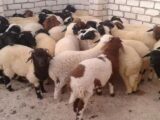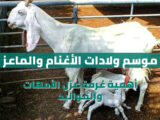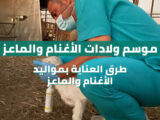Hello, fellow breeders! Today, we are discussing an important topic that concerns all animal breeders. Some individuals may not give it enough attention, and that is the proper steps to take when buying new animals and introducing them to your farm or enclosure, after agreeing with the seller.
First, it is essential to conduct a visual examination of the livestock and a laboratory test. The visual examination ensures the overall health and body condition of the animal, checking that it is in good health, not weak, and at an appropriate level of body fat. The fur should be soft and shiny, with no signs of hair loss or wear.
You should also make sure there are no diarrhea symptoms, and the mucous membranes of the eyes should be pink, with bright eyes and no nasal discharge. Laboratory testing is crucial, especially if the animals are for breeding purposes. Testing for brucellosis and checking for worm presence in feces samples, as well as blood tests to detect any blood parasites, are necessary. These tests are essential to ensure that any new livestock you bring into your farm or enclosure are healthy and free from contagious diseases that could potentially harm your herd.
Secondly, make sure to administer vaccinations to the livestock. Vaccines such as those for contagious pleuropneumonia, enterotoxemia, and Pasteurella, known as the ten livestock diseases, should be given. When transitioning livestock from one enclosure to another, changes in feed and stress during transport can make them susceptible to diseases. Therefore, it’s essential to ensure that the animals have received these vaccinations before moving them to the new enclosure.
Thirdly, regarding the transportation process of the livestock, give them supplements and boosters in their water or with their feed 48 hours before the transport. This includes vitamin C or vitamin A and E. Transportation should ideally occur in the early morning or before sunset, especially during the summer to avoid transporting livestock during the hot hours of the day, which can cause high stress even if the vehicle is equipped with temperature control.
As for the vehicle used for transporting animals, it’s best to have a dedicated vehicle equipped with shading to protect the livestock from weather conditions. The sides of the vehicle should be covered to protect the animals during transport.
Fourth, upon arrival at the new enclosure, receive the livestock in an isolation room separate from the other animal shelters. Ensure that this room is not downwind from the existing animal shelters, as this can prevent potential skin or respiratory diseases from spreading from the new animals to the existing ones. The isolation room should be located at least 20 to 25 meters away from the old shelters.
Additionally, after the livestock has been received and settled for an hour or two, provide them with a moderate amount of water and doses of fresh green grass if available. If not, offer small and frequent portions of dry grass. On the second day, gradually introduce concentrated feed over a week to ten days until they reach the standard feeding quantity for the animal’s digestive system.
These are crucial steps to ensure the health and well-being of new livestock introduced to your farm or enclosure. Proper care and attention to detail during the acquisition and transition process will help maintain a healthy and productive herd.




